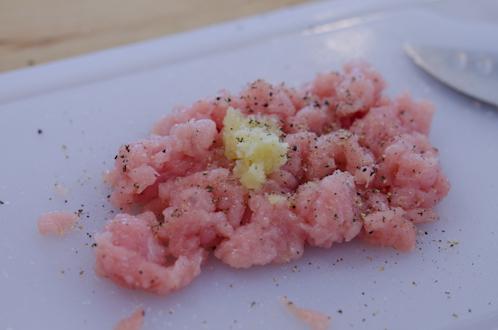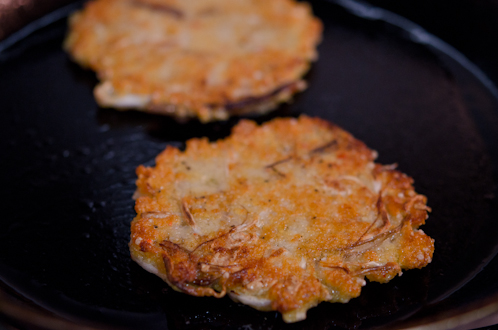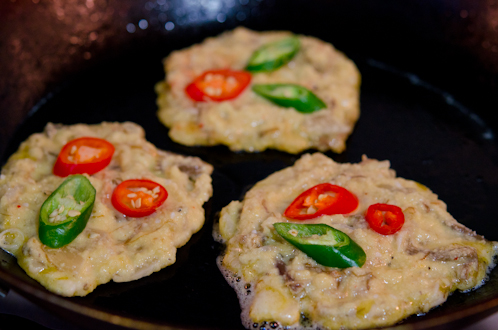Korean Mung Bean Pancakes (Bindaetteok)
| Korean mung bean pancakes are made with ground pork, mung bean puree, mung bean sprouts, and kimchi. There’s no added flour in the recipe, which makes this savory snack a wonderful gluten-free dish! |

If you like Korean style savory pancakes, you must try this bindaetteok recipe. These Korean mung bean pancakes are full of flavor and so delicious.
Bindaetteok (빈대떡) is filled with ground pork, coarse mung bean puree, mung bean sprouts, wild fern (fiddlehead, optional), and sour kimchi. As you can tell, the combination makes these little pancakes flavorful with a delightfully crunchy texture.
These lovely pancakes are often called a different name in Korea. Some people call it “nokdu jeon” (녹두전). Nokdu means split peas, which is the main ingredient in this recipe.
Although bindaetteok used to be considered as poor man’s fare, it’s an undeniable favorite with Koreans of every social class. It might have started as a humble dish for the commoners, but the flavor is as rich as the Queen of England.
Mung Beans (Split Peas)
Mung beans are tiny whole green-colored beans. I recommend using split mung beans; their skins have been removed revealing delicate yellow beans. You can find them easily in any Asian grocery store.
Recipe Instructions
Combine rinsed mung beans and rice in a large bowl. Add cold water and soak for at least 6 hours, up to 24, in the fridge. Drain and rinse them. Set aside.
This is Korean wild fern. Widely used in bibimbap and this bindaetteok. You can omit this if you can’t find it.
Blanch mung bean sprouts in boiling water for 1 minute and squeeze gently with both hands to remove the moisture.
Chop your fermented kimchi and set aside. The more sour your kimchi is, the better it gets.
My mouth is salivating just saying the word, “sour kimchi.” Gulp!
Season minced pork with garlic, salt and pepper and mix well.
Put the beans and rice in the blender and process with 1/4 cup water.
Add 1/2 cup kimchi juice for the blade to turn and stir a bit in the process so that they can blend easily. Do not over puree. It should be mildly coarse. Pour the mixture in a large mixing bowl.
Mix in all the ingredients.
Add soy sauce, salt, and pepper, and mix well.
Heat a generous amount of oil in the skillet over medium heat. Drop and spread 2-3 tablespoons of batter.
Cook for 3-5 minutes on each side until it get brown crisp. Add more oil if the pan seems dry.
Place a few slices of chilies on one side as a garnish if you like.
Yum, yum, yum!
Many Koreans eat these pancakes with soju, the Korean vodka, but they go just as well with any cold drinks.
Just like any savory pancakes, these should be eaten immediately when they are hot. They get tough once they’ve cooled down. As always, serve with a dipping sauce!
More Savory Korean Pancakes
- Korean Potato Pancakes (Gamja-jeon)
- Radish Pancakes
- Spinach Pancakes
- Korean Scallion Pancakes with Seafood (Pajeon)

Korean Mung Bean Pancakes (Bindaetteok)
Ingredients
- 2 cups dried split peas (mung beans), rinsed in a few change of water
- 1/4 cup short grain rice, rinsed
- 1/4 cup water
- 1/3 lb minced pork
- 2 cloves garlic, finely minced
- 1 1/2 cups fermented kimchi, chopped
- 4 oz mung bean sprout, blanched and squeezed to remove moisture.
- 3 oz Korean wild fern, sliced, optional
- 1/2 cup kimchi juice
- 1 tbsp soy sauce
- salt and pepper , to taste
- green/red chilies , sliced, optional
For dipping Sauce:
- 1/3 cup soy sauce
- 2 tbsp rice vinegar
Instructions
- Combine rinsed mung beans and rice in a large bowl. Add cold water and soak for at least 6 hours up to 24 in the fridge. Drain and rinse them. Set aside.
- Season minced pork with garlic, salt and pepper and mix well.
- Put the beans and rice in the blender and process with 1/4 cup water. Add 1/2 cup kimchi juice for the blade to turn and stir a bit in the process so that they can blend easily. Do not over puree, it should be coarsely smooth. Pour the mixture in a large mixing bowl
- Mix in pork, kimchi, mung bean sprouts, and fern with pureed beans and rice in the bowl.
- Add soy sauce, salt and pepper and mix well.
- Heat generous amount of oil in the skillet over medium heat and and spread 2-3 tablespoonful of batter. Cook for 3-5 minutes on each side until it gets golden brown. Serve hot with a dipping sauce
- To make the dipping sauce, mix soy sauce and vinegar in a small bowl. Serve with pancakes.















Helo;
Thank you for this most exciting recipe. I am most excited to give it a try. Can I use sauerkraut instead of the kimchi? i sometimes react to kimchi and I need a viable alternative for it. Also, is there a suitable sub for the wild fern? Thank you.
HI, i think you can use sauerkraut instead of kimchi. If you can’t find the fern, you can omit.
hi,
thank you for this recipe, the pancakes taste really great!
could recommend another recipe which using wild fern? i bought a whole bag and now i don’t know what to do with it….
thanks & hello from munich, germany
sophie
Try Bibimbap. https://www.beyondkimchee.com/bibimbap/
I’ve been making these pancakes with my Korean MIL for over 15 years on New Year’s Day, and I am thrilled to have found your easy to follow and common sense recipe!! The simple addition of the rice to the mung beans during soaking is the best tip!! Thank you so much for sharing your recipe. And, have a wonderful, healthy, delicious New Years!!
I am so glad to hear that my recipe is helping you to recreate the pancakes that you made with your MIL. Happy New Year to you!
Oh my! I have been searching for this recipe for years! I used to eat mung bean pancakes when I lived in a different city and love them. I made your recipe this weekend and they are simply gorgeous! I had to hunt to find kimchee, but it was so worth it. Thank you for sharing.
Thank you for sharing your recipe….and where did you get such lovely dinnerware? That set is gorgeous?
I made it today the first time. We had a big family so I doubled the amount of the recipe and was a little anxious how it would turn out. To my great relief, it was great!! Instead of pork, I added chopped squid and it was quite delicious too. I gave some to my son's friend who was here while I was cooking to take home. His mom called immediately after trying it. They were enjoying it too! Can the leftover pancake freeze well? Thank you.
Wahoo Korean food looks very délicious
I have to taste it 1 day 🙂
My halmoni just brought us a huge bag of dried yellow spit mung beans and i had no idea how to cook it. This recipe made me realize how long its been since i ate bindaetteok and i guess I will be eating it daily now. Thank you again for your great recipes 🙂
Surely. I'll check your site. Thank you.
Yes, you can keep the leftover batter in the fridge for up to couple days. You will see water is being separated from the batter, but just mix well before you cook again.
Hi Holly, those look really delicious! And I have enough 'old' kimchi left to make them! Just a question: would it be possible to keep leftover batter in the fridge to fry them the next day? Thanks!
I can't say exactly how many it will make. It will depends on how big each pancake you make. I made mine about 3" in diameter and I got about 20 pancakes. It will feed at least 4 people.
These look great! Can I ask how many pancakes the recipe makes, or for how many people?
Holly – Congrats on the guest post! The pancakes look delicious and pretty. Great post!
What an honor on the guest post! Congratulations. And this is a terrific recipe. I use mung beans a lot in dals and the like, but never in pancakes. I'll definitely give these a try – thanks.
Thank you for the idea. I've been trying to experiment kimchi recipes with my French friends here in France. I will try this recipe with lentils, perhaps. Is it possible to have your link to Koreataste.org to share your recipes? Thank you.
http://www.koreataste.org/lang/en/category/en/blogging-en/
Congratulations on your guest post!
This looks amazing. I have everything at home to make these! We use to do Korean pancakes, but then we found out that my kids are allergic to wheat and have been missing them a lot. This is a wheat free recipe! I am going to make them tonight! thanks 🙂
Of course you can. You need to soak the whole mungs bean overnight and rub them with both hands. The skin will come off easily if the beans are fully soaked, and will float to the top in the water while the yellow flesh will sink to the bottom. Rinse out the beans removing as much skins as possible. Some might not come off well, but it is okay.
Is it possible to use whole mung bean? I have a jar that needs to get used and was thinking that would be delicious. I have also used red lentils.
Thank you. Hope you can try soon.
Wow, these look and sound really delicious…!!! I have never heard of mung bean pancakes, but I know that that I'll give this recipe a shot as soon as I have mung bean in mypantry. I just checked out the Kimchi Chronicle website, it's so interesting, thank you for sharing, Holly :)!
Thanks. Bindaetteok is quite popular pancakes among Koreans and it's delicious.
Thanks, Erica.
Hi Holly! I'm so excited about your guest blog post! Congratulations, that is simply wonderful! 🙂
Congratulations on this awesome guest blogging opportunity! This is a very delicious first entry and something new to me as well.